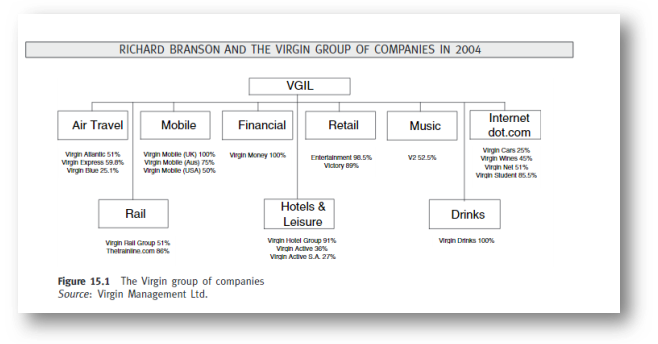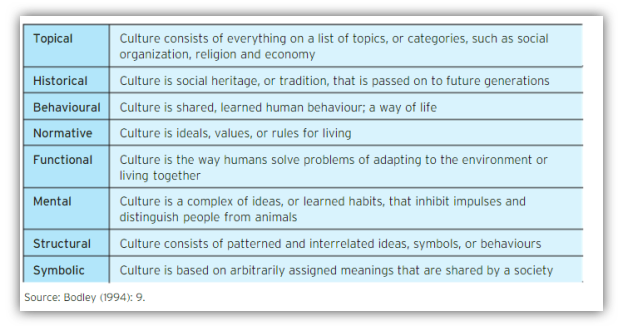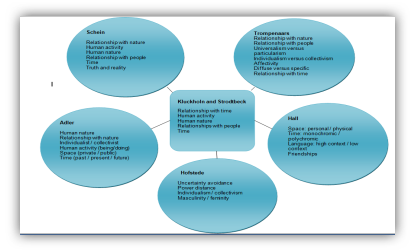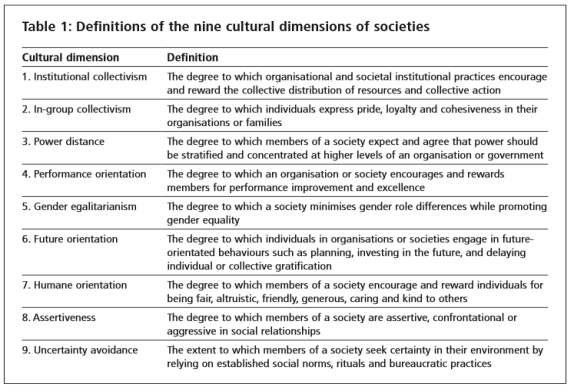Organisational Culture of Virgin
| ✅ Paper Type: Free Essay | ✅ Subject: Business |
| ✅ Wordcount: 2659 words | ✅ Published: 13th Sep 2017 |
The aim of the report is to examine different views and dimensions of organisational culture, outlining importance of the culture in the context of the impact on employee engagement for better performance, creating value for the customers and achieving organisational goals and objectives. The main focus will be on organisational practices that are adopted in Virgin Group in context of employee engagement which is in close relation to organisational culture and according to number of scholars plays vital role in organisation sustainability. After company overview follows theoretical framework with the theories and models of defining culture from academics well recognised in this field. Comparing and contrasting two culture dimension models will determine which model will be appropriate to be applied in order to define culture and employee engagement in Virgin Group.
Virgin Group is established by Sir Richard Branson in 1970 starting with Virgin Records and in 45 years that follows it became the world recognised brand that operates across five different sectors: travel, banking, entertainment, communications and health & fitness .and across three continents. With the headquarters in London, Virgin Group operates with over 400 companies in 60 businesses across three continents, employs more than 71,000 people that according to the founder Richard Branson are the key factor for the great customer experience which leads to company success (Virgin, 2016).
Get Help With Your Essay
If you need assistance with writing your essay, our professional essay writing service is here to help!
Find out more about our Essay Writing Service
The environment in which company operates is fast changing with the challenging markets, new technology and extended customer demand of value for money, therefore there is a constant need of quality improvements, new investments and awareness of the new trends in order to take competition to the next level (Grant, 2015).
The structure of Virgin Group is often linked to Japanese keiretsu and also brand franchising because of the member companies that are sharing common sense of identity and with the management and financial links between them. Although Richard Branson has limited formal linkages to the companies his influence is significant in the area of companies’ board of directors and in the use of Virgin brand (Grant, 2015).

Source: (Grant, 2015)
Number of researchers and experts in their field has made great efforts to define the concept of culture meaning that culture is difficult to define in only one facet, therefore Bodley (1994) in attempt to summarise outlined all facets that needs to be taken into account when defining a culture. Diverse definitions of culture are shown in the table below.
 Source: (Browaeys & Price, 2011)
Source: (Browaeys & Price, 2011)
Claver et al. (2001, p. 248) defined “organizational culture is a set of values, symbols and rituals, shared by the members of a specific firm, which describes the way things are done in an organization in order to solve both internal management problems and those related to customers, suppliers and environment” (Belias & Koustelios, 2014).
Following number of definitions of organisational culture the question arise about impact of the culture on organisational performance, leadership and organisational change and from which aspect the importance of the culture can be examined.
There is a suggestion by (Brown, 1992) that the key to effective leadership and also powerful tool for organisational performance improvement lies in organisational culture. However, the importance is given to the leaders knowledge in taking action using stories, myths, symbols and artefacts in reinforcing desired behaviour, not only to be aware of the organisational basic assumption.
In this context Richard Branson effective leadership can be good example in reinforcing desired behaviour in employees by telling stories that help to build trust and valuing the importance of truth and transparency so that employees can say to other people ‘yes, that’s the way our company is run’.” (Branson, 2016).
The impact of culture on performance can be seen from Peters and Waterman study of 62 American companies that have outstanding performance and their essential quality is proved to be dominance and coherence of culture. Moreover, the clearness of guiding values empowers the employees in knowing what they supposed to do in most situations without the need of policy manuals or detailed procedures and rules (Mullins, 2002).
Moreover, the study of Goldsmith and Clutterbuck identified eight characteristics that are built into organisational culture and from their study the key characteristic of the high performing companies is challenging culture. Also those companies are highly demanding in recruiting people who will work for them in order to fit into their culture. (Mullins, 2002)
Virgin Group recruiting process is highly demanding and according to Richard Branson “the qualifications are the least important attribute of a candidate “he puts emphases on importance of personality that can fit into Virgin culture (Branson, 2013).
Furthermore, culture has influence on behaviour on customers and clients and success in foreign markets expects company management to adopt product or service in order to fulfil different customer expectation and achieve greater customer satisfaction. In this context marketing and advertising of the company products or services in different markets must be aligned with the cultures of those markets in which company operates (Worthington & Britton, 2009).
In this context Virgin Atlantic, the largest company in Virgin Group engaged consultancy conducted research for customer experience on several routes including flights to Nigeria, China and Japan in order to ascertain to what extent cultural issues can affect passengers. Based on the research findings number of changes Virgin Atlantic introduced including new in- flight menus, new cultural awareness training for the crews and more native language crew recruited in order to deliver superior customer experience (Intersperience, 2011).
As defined previously organisational culture is important element of organisation especially in today globalisation and expansion of the multinational businesses. The process when culture is developing and extent in which that culture will stay stable or not depends of certain changes over the time and different environmental influences. In a context of business, development of culture can be seen within departments or in different levels of hierarchy in the organisation or between collections of companies in the particular sector. Shared experience can be related to a country or regions where nations have in common religion, language or history. Furthermore, Tayeb (2003) identifies elements that have contribution in building national culture including: Family, Religion, Education, Mass Communication Media and Multinational Companies. In an organisational context national culture can have impact on development of corporate culture in a multinational company and knowledge of the dimension of the national culture can be very useful in communication and working with different cultures (Hill, 2010).
Conceptualisation of the culture in the dimensions enables quantifying of the variations between cultural attributes and there are certain researchers who developed models of dimensional approach that can be useful in cross cultural comparison (Browaeys & Price, 2011).
Schein (2001) indentifies three distinct layers in his conceptualisation of culture starting with the surface level with artefacts which are visible, tangible or audible in forms of dress codes, office layout, technology, language and structure of the organisation can be discerned. Values and believes are in the second level including attitudes, moral and ethical codes, ideologies and philosophies that are deeply integrated in the organisational culture. In the deepest levels are basically the fundamental values that are often taken for granted because of its unconscious including truth and spirit. However, it is noted that organisations usually are not consisted from only one culture but there are different subcultures as well (Abubakar & Dogoji, 2015).
Trompenaars and Hampden-Turner, (1997, p. 6) argue that nations major cultural differences affect the way of doing business and the way of managing the organisation in which context culture is understood as “the way in which a group of people solves problems and reconciles dilemmas” (Balan & Vreja, 2013).
Trompenaar’s dimensions can give insight into the variety of problems that can arise in context of company to company, company to customer and face to face and indicates cultural characteristic that can be expects from a company in particular country (Rugman, Collinson, & Hodgetts, 2006).
Arguably, the concept developed by Trompenaars does not suggest how people’s preferences can be measured in each dimension, but rather highlights different people’s choices as a result of different cultural backgrounds (Pagell, Katz, & Sheu, 2005).
Key Dimensions of Culture

Source: Adapted from (Browaeys & Price, 2011)
Concepts previously mentioned are by no means the only that are developed and formulated by the researchers and scholars in this field. For instance, one well known concept is widely used to determine organisational culture that is proposed by Geert Hofstede (Magnusson, Wilson, Zdravkovic, Zhou, & Westjohn, 2008) .
Cultural framework of Geert Hofstede is build on the research conducted between 1967 and 1973 trough surveys of IBM employees in more than 40 countries with the intention to extract their cultural attributes and resulted with developing set of cultural dimensions that can be measured in order average value to be obtained for the certain group of people and in that way to have national culture attributes measured. Hofstede identified five dimensions: Power Distance, Uncertainty Avoidance, Individualism, Masculinity and Long -term Orientation (Venaik & Brewer, 2010).
Hofstede’s concept has been widely used by number of international studies and researchers that recognised its work as established in assessing culture on national level .Hofstede’s work according to Smith (2006:915) has “served as a marker post for subsequent investigators for two decades” (Venaik & Brewer, 2010) .
Nevertheless, Hofstede work is also mostly criticised concept on overlapping significantly among cultural dimensions and arguably some authors questioned reliability of his dimensions (Blodgett, Bakir, & Rose, 2008).
GLOBE is a project conceived and led by Robert J. House and inspired by Hofstede (1980) with intention to validate and test relationship between culture and leadership effectiveness. Furthermore, cultural dimensions were developed on the base of interviews in several cultures and existing organisational and cultural theory. GLOBE research project resulted with additional advancement of nine independent culture dimensions (Magnusson, Wilson, Zdravkovic, Zhou, & Westjohn, 2008).
Javadan and House,(2001) states that GLOBE project focused on leadership effectiveness and behaviour in relation to national culture was wide-scale study with more than 150 researchers that collected information from 18000 middle managers in 62 countries. The conclusion reached from the research is that multi -dimensional nature of culture can give explanation of the variations in managerial decision making and behaviour. (Pagell, Katz, & Sheu, 2005)

Source:(House, Quigley, & de Luque, 2010)
Both culture concepts of Hofstede and GLOBE are highly valuable for better understanding of national cultural differences, cultural influence on organisational practices and leadership in today business globalisation and multinational corporations (Shi & Wang, 2011).
According to (Hofstede, 2006) differences are identified in comparison between Hofstede (1980) and GLOBE concept in seven points: New data versus existing data; Team versus single researcher; Managers versus employees; Theory-driven versus action-driven; US inspired versus decentred; Organizational culture as similar or different in nature to/from societal culture ;National wealth as a part or as an antecedent of culture.
In addition to those differences, Hofstede research is based on one multinational company IBM, fact that raise question of the validity compared to GLOBE research conducted on 951 non-multinational organisations and according to Pramila (2009) in GLOBE study cultural dimension are introduced in organisational and societal level and new performance dimension has been introduced (Shi & Wang, 2011).
Taking into account all differences and similarities between two concepts the most appropriate model to be applied in defining Virgin Group culture and its impact on organisational practices will be GLOBE because of possibility of applying wider range of dimensions that will give better understanding of culture and employee engagement in Virgin Group. Also one of the main reasons for applying GLOBE is its relation with the leadership and employee engagement and possibility of application of the performance dimension that is not present in Hofstede framework but is significantly relevant to organisational practices in Virgin Group.
Number of definitions are presented to define term organisational practice including following definitions from Schatzki, (2001) stating that practice is “embodied, materially mediated arrays of human activity centrally organised around shared practical understanding” and definition from Schau et.al, (2009) stating that “practices are linked and implicit ways of understanding, saying, and doing things” (Jansson, 2013).
Virgin Group employs several practices which significantly defers them from competitors in the area of employee engagement and customer service experience. Most of the companies have emphases on customer satisfaction, meaning they put customer as a first and most important while Virgin Group gives priority to the employees before customers and shareholders with the Richard Branson’s philosophy that if the employees are treated well they can deliver excellent customer service and it will be beneficial for the shareholders as well (Branson, 2014).
The reason behind the choice of employee engagement is because this cultural aspect is not enough explored and having in mind importance of the human factor in the organisational performance there is a need of more analyses and different views. Employee engagement as defined by Mercer “refers to psychological state where employees feels a vested interest in the company’s success and perform to a high standard that may exceed the stated requirements of the job” (Truss, Alfes, Delbridge, Shantz, & Soane, 2014).
Employee engagement practices in Virgin Group analysed by applying Globe nine dimensions can give insight in organisational culture and identified what makes them different from other cultures having in mind that Virgin Group operate across three continents.
Cite This Work
To export a reference to this article please select a referencing stye below:
Related Services
View allDMCA / Removal Request
If you are the original writer of this essay and no longer wish to have your work published on UKEssays.com then please:



